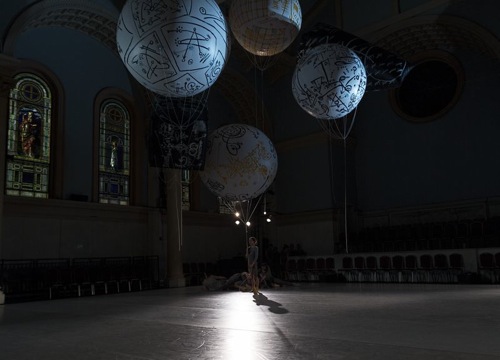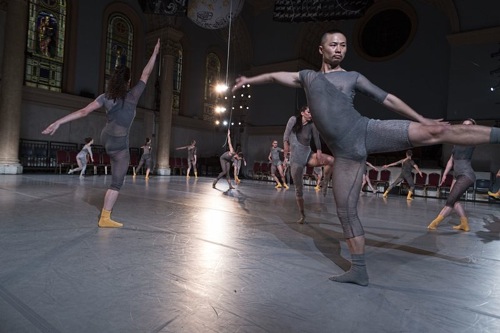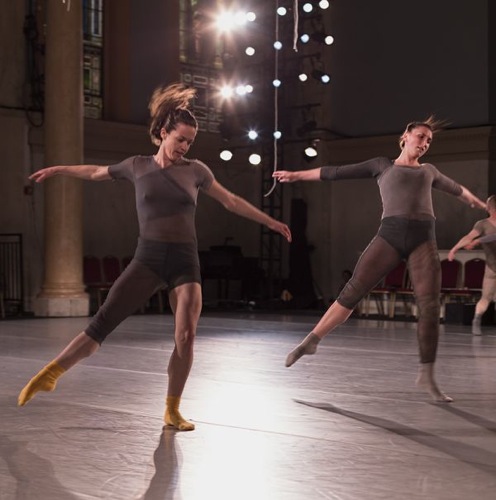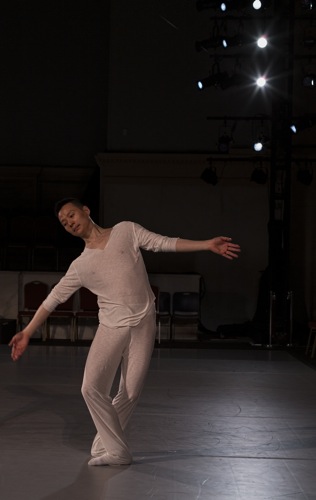Shen Wei Dance Arts presents Map at Judson Church, April 29 through May 4
In Judson Church’s open, lofty space, Shen Wei’s restaging of his 2005 Map looks and feels far more three-dimensional than the version that premiered at Lincoln Center on a proscenium stage. The Judson spectators sit on four sides of the large arena, some of them on the small, high stage made to hold the altar. The dancing is almost palpable. You imagine that you could reach out and touch one of the performers; you could, perhaps, join them as they swirl over the gray floor, forming waves and whirlpools that wash no one up and suck no one down.
Shen, a master of visual arts as well as choreography, has altered his original set (in effect, a backdrop) to suit the audience’s four-sided view. Seven immense balloons hover together in the center of the space, anchored to the floor by their strings. Four are round and white; three are black and cuboid. All are covered with markings that can be read as maps of the dance’s choreographic process—notes and diagrams and lines to indicate paths. In the darkness before the piece starts, the balloons are released and float up.
When the music, excerpts from Steve Reich’s formidable The Desert Music, begins its rich opening selection, dancers are lying on the floor as if slumbering. Scott Bolman’s fine lighting is initially dim and, like the floor, the people are gray—costumed in outfits that are semi-transparent in places with heavier contrasting fabric elsewhere (the ingenious designs are by Shen and Elena Comendador). They spend the entire first “map” (titled “Rotate”) on the floor: rolling and uncurling; swinging one leg across the other; pressing up, butts first, and smoothly twisting down again. They travel like semi-ambulatory sea creatures covering ground very gradually yet sinuously active. Others join, and they form squads that, at one point, shape the repeating movement phrase into four-part counterpoint.
Map is a feast of complex fluidity. The sixteen members of Shen Wei’s Dance Arts are adroit at letting a movement impulse animate a shoulder, slip to an elbow, glide to a hip, be received by a foot. Sometimes these impulses begin in the center of the body and travel circuitously outward. Often the dancers seem to be spiraling around themselves, crossing one foot over the other and letting it pull them into twist. Sharpness also figures in their dance vocabulary. In one section, they jut their hips bouncily forward and back and let their arms swing loosely around their bodies. In another, a couple of them persist in moving in mechanical increments, while more and more of the others join a smoother, more expansive phrase.
Reich’s music provides a strong rhythmic base, but this can drop deep into a landscape animated by, say, high, ringing sounds and chorusing voices (the words, taken from poems by William Carlos Williams, are not always understandable). The forces that animate this terrain conjure up images of wind as well as watery ones. Wearing socks that mute the sounds of their feet, the dancers rush smoothly here and there in groups, curving and leaning in response to variations in the breeze. In one sequence, some of them dance clustered, while Janice Lancaster Larsen rushes around them in circles, revolving and leaping as she goes, as if blown by a storm in the making.
Shen’s choreography for Map encompasses boldness but not harshness, softness but not indolence, vigor without muscular display. Its tone suggests an aim to explore and purify rather than to entertain or create dramas. Others have described it as occasionally witty, although I don’t notice that. Once a dancer reaches up, grasps a balloon’s string, and pulls it down a little, holding it there while others begin a new section. Like Map as a whole, the still person and the obedient balloon suggest buoyancy under control and a playful compliance with gravity.
Evan Copeland, Kate Jewett, Cynthia Koppe, Ricardo Zayas, and Lancaster Larsen have been performing with Shen Wei Dance Artists the longest, but all of the dancers enter wonderfully into the spirit of choreography that is tidal yet allows individuals to float and spurt to the surface.
Dancing alone in his new Variations, Shen eschews the stunning visual imagery that characterizes his work. He’s alone in the space, dressed in white, and accompanied on the piano by Steven Gosling playing Arvo Pärt’s spare 1977 Variations for the Healing of Arinushka (Arinushka was a folk music ensemble in the composer’s native Estonia). The music begins with a simple single-note melody that climbs, falls a little, climbs again, and so on until it settles back down. Gradually the variations thicken it, but not much.
Shen, too, builds from a simple base. Watching him, you might say to yourself, “he comes in peace.” His very appearance is centered, meditative, almost neutral. He could be twenty years old or fifty. With a slim, compact body, a long neck, and supple arms, he dances as if communicating with the particularities of his body, the air around him, and the ground under his feet. His background in Chinese painting and calligraphy still traces its way through his contemporary vision.





Deborah
You truly captured a remarkable evening of dance – your language so vividly described what I experienced
I loved the performance
thanks
c
Cherylyn said it all. I was there, too, sitting upstairs in the mezzanine. You really nailed it. The concert, beautiful as it was, was enhanced by your eloquent description of it. BRAVA!
Yes, such a beautiful description. Unfortunately I missed the performance, but the stunning photos you have provided leave me hungry for more…next time for me…sob 🙁
What a pleasure to replay the evening’s performance through your beautiful, vivid, animated text. The description parallels my experience. Thanks!